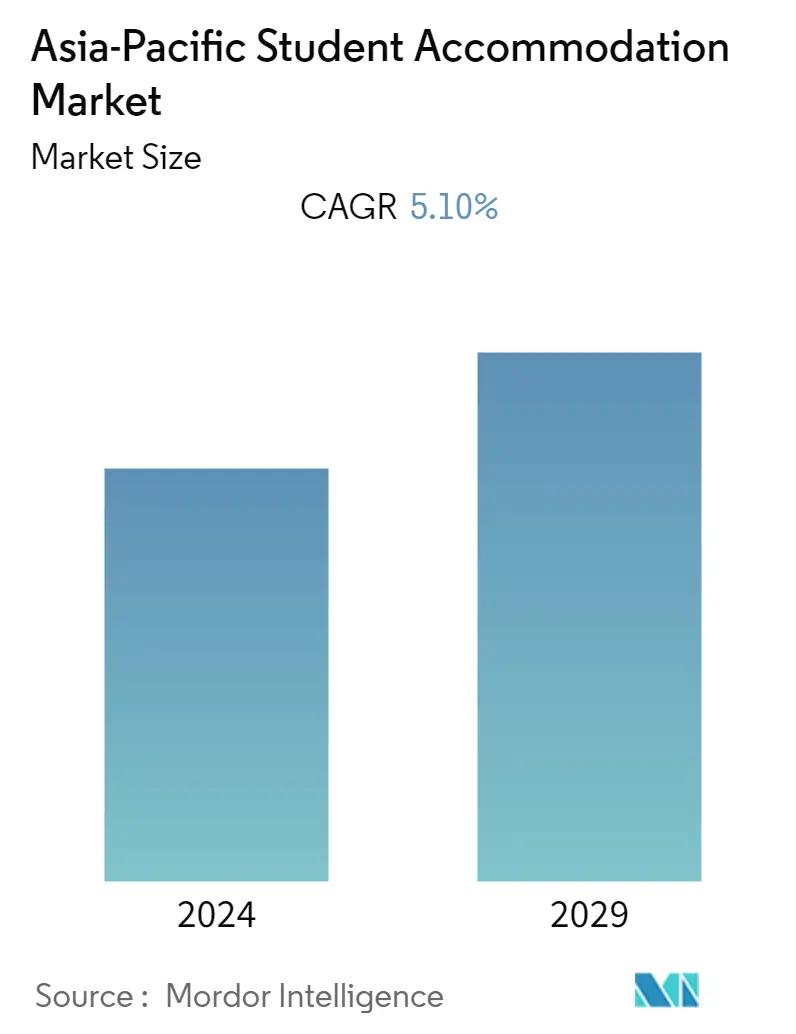Market Size of Asia-Pacific Student Accommodation Industry

| Study Period | 2020 - 2029 |
| Base Year For Estimation | 2023 |
| Forecast Data Period | 2024 - 2029 |
| Historical Data Period | 2020 - 2022 |
| CAGR | 5.10 % |
| Market Concentration | Medium |
Major Players
*Disclaimer: Major Players sorted in no particular order |
Asia-Pacific Student Accommodation Market Analysis
The Asia-Pacific student accommodation market has generated revenue of USD 3.7 billion in the current year and is poised to register a CAGR of 5.1% for the forecast period.
Students' mobility was temporarily affected by travel restrictions during the pandemic, with some international students unable to move back into their university accommodation and others stranded overseas transitioning to online learning. Uncertainty remains over travel restrictions, especially from China, which has the highest number of students in higher education institutions, especially in Australia and Japan. Still, there have been encouraging signs in recent months, with borders reopening and students returning to in-person learning. The post-COVID-19 environment had a positive effect on a variety of factors, including the lifting of flight and travel restrictions, the lifting of quarantine measures, the reopening of restaurants, the commencement of indoor and outdoor events, and the resumption of the overall halt. As a result, the market has experienced a post-COVID-19 boom.
The Asia-Pacific region has been experiencing a steady increase in international and domestic student enrollment, driving the demand for student accommodation. Major cities with renowned universities have been hotspots for this trend. Student accommodation options in the region vary widely, from traditional dormitories to purpose-built student housing (PBSA), private apartments, and homestays. PBSA has been gaining popularity due to its amenities and services tailored to students.
The student housing sector in Asia Pacific has attracted significant investment from both domestic and international investors. This has led to the development of modern and sophisticated student housing complexes.
Asia-Pacific Student Accommodation Industry Segmentation
Student accommodation is a type of residential accommodation that provides a safe and professionally managed environment for students who are enrolled at an educational institution. It includes communal areas such as lounge/dining rooms, kitchens, and bathrooms that are serviced and maintained on a daily/weekly basis and are suitable for both academic pursuits and personal well-being.
The Asia-Pacific student accommodation market is segmented by type (PG, home-stays, student apartments, on-campus housing, off-campus housing, dormitories, etc.), by service type (Wi-Fi, laundry, utilities, dishwashers, parking), by application (graduates, sophomores, post-graduates, other service types), and by geography (India, China, Japan, South Korea, and the Rest of Asia-Pacific).
The report offers market sizes and forecasts for the Asia-Pacific student accommodation market in USD for all the above segments.
| By Type | |
| PG | |
| Home-stays | |
| Student Apartments | |
| On-Campus hosuing | |
| Off-Campus Housing | |
| Dormitory | |
| Other Types |
| By Service Type | |
| Wi-Fi | |
| Laundry | |
| Utilities | |
| Dishwasher | |
| Parking |
| By Application | |
| Graduates | |
| Sophomore | |
| Post-Graduates | |
| Other Applications |
| By Geography | |
| India | |
| Japan | |
| China | |
| South Korea | |
| Rest of Asia-Pacific |
Asia-Pacific Student Accommodation Market Size Summary
The Asia-Pacific student accommodation market is experiencing a resurgence following the disruptions caused by the pandemic, which temporarily hindered student mobility due to travel restrictions and online learning transitions. The lifting of these restrictions has led to a positive market outlook, with students returning to in-person learning and driving demand for various accommodation options. The region is witnessing a steady increase in both international and domestic student enrollments, particularly in major cities with prestigious universities. This demand is further fueled by the popularity of purpose-built student housing (PBSA), which offers tailored amenities and services, attracting students seeking a higher quality of life. The sector has seen significant investment from both domestic and international investors, leading to the development of modern student housing complexes in urban areas.
The market is characterized by a diverse range of accommodation options, including traditional dormitories, private apartments, and homestays, with PBSA gaining traction due to its cost-effectiveness and convenience for students. The rise in higher education pursuits and international education has created a robust demand for student accommodation near universities and colleges. The market is dominated by a few major players, but technological advancements are enabling mid-size and smaller companies to expand their presence. Recent innovations, such as AI-driven tools for accommodation search, are enhancing the student housing experience. The sector's potential for stable rental income and high occupancy rates continues to attract institutional investors and real estate developers, underscoring its growth prospects in the coming years.
Asia-Pacific Student Accommodation Market Size - Table of Contents
-
1. MARKET INSIGHTS AND DYNAMICS
-
1.1 Market Overview
-
1.2 Market Drivers
-
1.2.1 Universities Offering On-Campus Student Housing
-
1.2.2 Rising Demand for High Quality Accomodations
-
-
1.3 Market Restraints
-
1.3.1 Demand and Supply Imbalance
-
1.3.2 Rising universities fees
-
-
1.4 Industry Attractiveness - Porter's Five Forces Analysis
-
1.4.1 Bargaining Power of Suppliers
-
1.4.2 Bargaining Power of Buyers
-
1.4.3 Threat of New Entrants
-
1.4.4 Threat of Substitutes
-
1.4.5 Intensity of Competitive Rivalry
-
-
1.5 Insights on Current Trends and Innovations in the Market
-
1.6 Impact of COVID-19 on the Market
-
-
2. MARKET SEGMENTATION
-
2.1 By Type
-
2.1.1 PG
-
2.1.2 Home-stays
-
2.1.3 Student Apartments
-
2.1.4 On-Campus hosuing
-
2.1.5 Off-Campus Housing
-
2.1.6 Dormitory
-
2.1.7 Other Types
-
-
2.2 By Service Type
-
2.2.1 Wi-Fi
-
2.2.2 Laundry
-
2.2.3 Utilities
-
2.2.4 Dishwasher
-
2.2.5 Parking
-
-
2.3 By Application
-
2.3.1 Graduates
-
2.3.2 Sophomore
-
2.3.3 Post-Graduates
-
2.3.4 Other Applications
-
-
2.4 By Geography
-
2.4.1 India
-
2.4.2 Japan
-
2.4.3 China
-
2.4.4 South Korea
-
2.4.5 Rest of Asia-Pacific
-
-
Asia-Pacific Student Accommodation Market Size FAQs
What is the current Asia-Pacific Student Accommodation Market size?
The Asia-Pacific Student Accommodation Market is projected to register a CAGR of 5.10% during the forecast period (2024-2029)
Who are the key players in Asia-Pacific Student Accommodation Market?
Mapletree Investments, STUHO, Nest Student Housing, Prime Student Living and My Student Villa are the major companies operating in the Asia-Pacific Student Accommodation Market.

